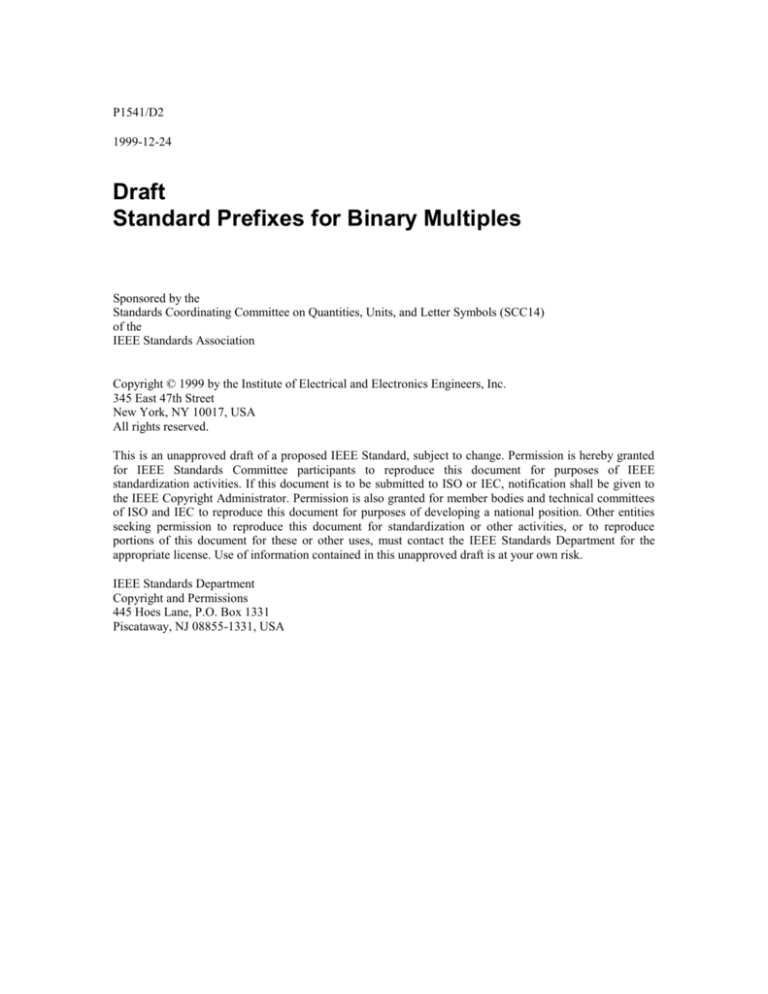
P1541/D2
1999-12-24
Draft
Standard Prefixes for Binary Multiples
Sponsored by the
Standards Coordinating Committee on Quantities, Units, and Letter Symbols (SCC14)
of the
IEEE Standards Association
Copyright © 1999 by the Institute of Electrical and Electronics Engineers, Inc.
345 East 47th Street
New York, NY 10017, USA
All rights reserved.
This is an unapproved draft of a proposed IEEE Standard, subject to change. Permission is hereby granted
for IEEE Standards Committee participants to reproduce this document for purposes of IEEE
standardization activities. If this document is to be submitted to ISO or IEC, notification shall be given to
the IEEE Copyright Administrator. Permission is also granted for member bodies and technical committees
of ISO and IEC to reproduce this document for purposes of developing a national position. Other entities
seeking permission to reproduce this document for standardization or other activities, or to reproduce
portions of this document for these or other uses, must contact the IEEE Standards Department for the
appropriate license. Use of information contained in this unapproved draft is at your own risk.
IEEE Standards Department
Copyright and Permissions
445 Hoes Lane, P.O. Box 1331
Piscataway, NJ 08855-1331, USA
1999-12-24
P1541/D2
Introduction
[To be prepared]
(This introduction is not part of IEEE P1541, Standard Prefixes for Binary Multiples.)
This standard was prepared by a subcommittee of IEEE SCC14 that comprised the following members:
James R. Frysinger, Chair
Gordon Aubrecht
Bruce B. Barrow
Stanley Ehrlich
David Goldman
Stan Jakuba
Joseph Langenstein
John Scott
Ralph Showers
Barry N. Taylor
Lorelle Young
Alan Zuckerwar
The following persons were on the balloting committee: (To be provided by IEEE editor at time of
publication.)
Copyright © 1999 IEEE. All rights reserved.
This is an unapproved IEEE Standards Draft, subject to change.
ii
1999-12-24
P1541/D2
Contents
Introduction .................................................................................................................................................... ii
1. Overview ..................................................................................................................................................... 5
1.1 Scope ..................................................................................................................................................... 5
1.2 Purpose .................................................................................................................................................. 5
2. Definitions ................................................................................................................................................... 5
3. Prefixes for binary multiples........................................................................................................................ 5
4. Principles of usage ....................................................................................................................................... 6
4.1 The SI prefixes ...................................................................................................................................... 6
4.2 Application of the prefixes for binary multiples .................................................................................... 6
5. Bibliography ................................................................................................................................................ 7
Copyright © 1999 IEEE. All rights reserved.
This is an unapproved IEEE Standards Draft, subject to change.
iii
1999-12-24
P1541/D2
Draft Standard Prefixes for Binary Multiples
1. Overview
This standard is divided into three clauses. Clause 1 states the scope and purpose of the standard. Clause 2
defines the prefixes for binary multiples. Clause 3 gives guidance on the application of these prefixes.
1.1 Scope
This standard defines names and letter symbols for prefixes that denote multiplication of a unit by the
binary multiplier 210 and powers thereof. The prefixes are for use with all units, in all fields, where
multiplication by a binary multiplier is found to be appropriate.
1.2 Purpose
In recent years confusion has resulted from the fact that the SI prefixes—kilo, mega, giga, etc. —have been
used sometimes with their correct meaning as decimal multipliers, and sometimes with a special meaning as
binary multipliers. The purpose of this standard is to establish prefixes for binary multiples in order to make
precise and unambiguous communication possible, especially within the fields of data processing and
information systems. This standard is fully consistent with an equivalent standard that has been adopted by
the International Electrotechnical Commission [B1].
2. Definitions
2.1 bit: binary digit
2.2 byte: a group, usually eight, of adjacent bits operated upon as a unit
2.3 octet: a group of eight adjacent bits operated upon as a unit
3. Prefixes for binary multiples
The prefixes given in Table 1 shall be used to indicate multiplication by powers of 2 10.
PLACE TABLE 1 HERE
Table 1—Prefixes
Factor
Name
Symbol
Origin
Related SI Prefixes
210
kibi
Ki
kilobinary: (210)
kilo: (103)
k
220
mebi
Mi
megabinary: (210)2
mega: (103)2
M
Copyright © 1999 IEEE. All rights reserved.
This is an unapproved IEEE Standards Draft, subject to change.
5
1999-12-24
Example:
—
—
—
—
—
P1541/D2
230
gibi
Gi
gigabinary: (210)3
giga: (103)3
G
240
tebi
Ti
terabinary: (210)4
tera: (103)4
T
250
pebi
Pi
petabinary: (210)5
peta: (103)5
P
260
exbi
Ei
exabinary: (210)6
exa: (103)6
E
one kibibit
one megabyte
one mebibyte
one megaoctet
one mebioctet
1 Kib = 210 b = 1024 b
1 MB = 106 B = 1,000,000 B
1 MiB = 220 B = 1,048,576 B
1 Mo = 106 o = 1,000,000 o
1 Mio = 220 o = 1,048,576 o
Note: In English the first syllable in the binary prefix name should be pronounced in the same way as in the
first syllable of the corresponding SI prefix. The second syllable should be pronounced “bee”.
4. Principles of usage
4.1 The SI prefixes
The SI prefixes shall not be used to denote multiplication by powers of two.
4.2 Application of the prefixes for binary multiples
The general public is becoming better and better acquainted with the International System of Units (SI), the
modern metric system, and will normally interpret kilo, mega, etc., in their proper decimal sense. The
prefixes for binary multiples make it possible for specialists in the information sciences to communicate
with precision. The use of these prefixes should be restricted to audiences that are familiar with
mathematical notations such as 210 and (210)n. They should not ordinarily appear in the descriptive
literature, such as instruction manuals and labels, that accompanies products sold to the general public.
Example 1: The common 90-mm diskette, as formatted for PC use, is usually advertised as containing 1.44
megabytes. It is actually formatted for 1440 kibibytes, and the “mega” in this application is neither a proper
decimal prefix nor a binary prefix. The resulting hybrid “megabyte” is equal to 1000 kibibytes. In
communication with the general public the capacity of the diskette should be listed as 1.47 MB.
Example 2: The following “Frequently Asked Question” appears in an instruction manual widely
distributed in 1999:
Q: The formatted capacity of my hard drive seems smaller than what was ordered. Why?
A: Your operating system assumes that 1 MB equals 1,048,576 bytes. Drive manufacturers
consider 1 MB as equal to 1,000,000 bytes. Thus if the drive is advertised as 6.4 gigabytes
(6,400,000,000 bytes) the operating system sees it as approximately 6.1 GB
(6,400,000,000/1,048,576,000 = 6.1035…).
Note that in this example the “gigabyte” is equal to 1000 mebibytes.
Copyright © 1999 IEEE. All rights reserved.
This is an unapproved IEEE Standards Draft, subject to change.
6
1999-12-24
P1541/D2
5. Bibliography
[B1]
International Standard IEC 60027-2, Letter symbols to be used in electrical technology, Part 2:
Telecommunications and electronics, Amendment 2, 1999-01.
Copyright © 1999 IEEE. All rights reserved.
This is an unapproved IEEE Standards Draft, subject to change.
7








